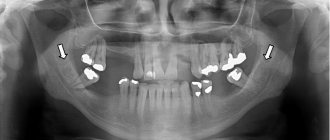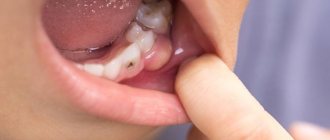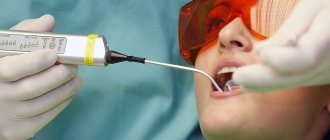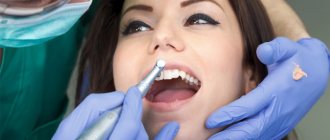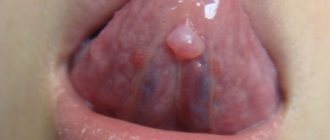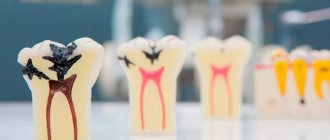What is a dental cyst?
Tooth cyst - what is it? An odontogenic cyst is a pathological neoplasm that occurs in the upper part of the tooth root. The internal cavity of the cyst is filled with liquid or mushy purulent contents; it is enveloped by a dense layer of epithelium.
The size of the cyst starts from a few millimeters, with rapid development reaching several centimeters in circumference. Most often, the pathological process affects the upper jaw, since the roots of its teeth have a more porous structure.
In order to understand what a dental cyst is and how to treat it, you need to know why such a phenomenon occurs. The formation of cysts occurs as a result of inflammation, thus the body restricts healthy tissue from the affected areas, clogging them along with bacteria into bubbles.
Rules for taking antibiotics after wisdom tooth removal
Regardless of the type of antibacterial drug prescribed by the doctor, after a wisdom tooth has been pulled out, it is recommended to strictly follow the basic rules for taking it:
- It is recommended to avoid the consumption of alcoholic beverages during antibacterial therapy.
Strict adherence to the regimen and dosage of the prescribed antibiotic.
- The optimal time to take the drug is an hour before a meal, or 2 hours after eating it.
- The drug is washed down with exclusively purified plain water. The use of juices and mineral water for these purposes is unacceptable.
- When taking other drugs in parallel, their compatibility should be taken into account.
- It is recommended to avoid the consumption of alcoholic beverages during antibacterial therapy.
- In order to avoid disturbances in the flora of the oral cavity and intestines, antifungal medications or probiotics are taken in parallel.
- If after taking antibiotics their effectiveness does not appear or side effects occur, the drug should be replaced with a more suitable one.
- Independent interruption of the course of therapy is not allowed.
Important! Improper use of antibacterial drugs can provoke the development of side effects. This will not only aggravate the recovery process after wisdom tooth removal, but can also provoke the development of other serious pathological processes.
Causes
There are several reasons why a dental cyst develops. The main reason is the activity of pathogenic microorganisms in a closed dental space; the following risk factors contribute to this:
- severe pathology, lack of timely treatment and incorrect treatment of dental diseases - caries, periodontitis, pulpitis;
- infectious complications after tooth filling, implantation procedures - in such cases, the doctor removes not only the cyst, but also the crown or implant, this avoids relapse;
- complications during teething, especially when wisdom teeth erupt - dental tissues injure the gums, bacteria get into microcracks,
- microorganisms also enter wounds that form due to mechanical damage to teeth;
- Nasopharyngeal diseases – infections in the nose and throat can spread to the oral cavity.
To provide adequate treatment, it is necessary to accurately determine the cause of the development of a dental cyst; based on it, the dentist will prescribe suitable therapy. So, in cases of injury, treatment consists of removing the cyst and tissue regeneration, but if the cyst is a complication of another disease, then in addition to removing the vesicle, the patient will be prescribed treatment for the underlying disease.
Possible complications
Incorrect dosage, non-compliance with the rules for taking medications, as well as incorrectly selected medications can provoke the following unpleasant consequences:
- Alveolitis is an inflammation of the socket of an extracted tooth.
- Periodontitis is an inflammatory process that develops in the soft tissues surrounding the empty socket.
- Flux is inflammation of the periosteum.
- Osteomyelitis is purulent-necrotic processes affecting the jaw bone tissue.
So, in modern dental practice, after tooth extraction, if there are indications (inflammatory processes, certain chronic diseases, problems with blood clotting), it is customary to prescribe antibacterial therapy. Why are such drugs needed?
The main task of antibiotics is to fight pathogenic microflora: pathogens of inflammation, the cause of suppuration and a number of other postoperative complications. Whether it is necessary to take medications is decided in each specific case by the dentist, based on the characteristics of the individual patient’s body and the presence of concomitant dental (systemic) diseases.
Types of dental cysts
Tooth cysts have different classifications, each of which is formed according to certain characteristic parameters of the pathology.
According to the nature of the disease, they are distinguished:
- residual cysts – occur after tooth resection (removal) surgery; this is the most common type of cyst;
- retromolar – formed during severe eruption of wisdom teeth;
- radicular - cysts are located on or near the tooth root;
- follicular – at the heart of such cysts is the germ of a permanent tooth; follicular neoplasms arise as a result of poor quality care of baby teeth.
Classification of neoplasms according to their origin:
- odontogenic – arise as a result of the transition of the inflammatory process from other dental diseases;
- non-odontogenic - the causes of the development of such cysts include problems not related to the teeth and oral cavity.
Locations of cystic formation:
- anterior teeth;
- teeth that are adjacent to the nasal sinuses with their roots;
- wisdom teeth.
How to select medications
The answer to the question of whether you need to take antibiotics after tooth extraction has been received. Now it is necessary to find out what means should be taken in this or that case. The selection of a drug for a child or adult patient is carried out based on the general condition of the patient’s body, the presence (absence) of an allergic reaction to certain medications, the localization and degree of the inflammatory process.
Antibiotics after tooth extraction must meet the following requirements:
- medicinal components must penetrate well not only into the gum tissue, but also into the bone tissue;
- ensuring a cumulative effect for prolonged action of the drug;
- maintain the required concentration for at least 8 hours so that the patient can conveniently take medications (not “get out of line” with the therapy regimen);
- Aerobic and anaerobic microflora must be susceptible to the antibiotic;
- minimum side effects, minor toxic effects on the body;
- the product must be suitable for outpatient treatment.
Inflammatory processes, bacterial infections, and other associated dental problems are the main indications for antibiotic therapy after tooth extraction
Symptoms
The danger of a dental cyst lies in the fact that signs of pathology appear only when the neoplasm reaches a relatively large size. In the early stages, small cysts do not manifest themselves in any way, meanwhile the infectious process covers an increasingly larger area of healthy tissue. In the initial development of pathology, cysts are discovered by chance during routine examinations or treatment of other diseases.
The duration of the formation of a dental cyst takes only 1-2 days; as it develops, the following symptoms may occur:
- unpleasant and even painful sensations in the tooth, which intensify when chewing solid food;
- protrusion of the gum of a tooth, in the area of the root of which a cyst forms, the growth of the gum becomes larger over time, redness is observed;
- the formation of a fistula in the area above the root of the tooth, the release of serous or purulent accumulations from it;
- general weakness and malaise;
- increase in body temperature.
Note! When a dental cyst occurs, the symptoms are not immediately visible; they appear in the later stages of development. The pain when a tumor appears is aching in nature, but it is less pronounced than the pain caused by caries and pulpitis.
If a clinical picture occurs and you suspect a pathological process, be sure to consult a doctor. Under no circumstances should you resort to self-treatment - the dental cyst must be removed. In addition, taking the wrong medications can worsen the patient’s overall well-being.
Sometimes there is no pain in the oral cavity; instead, the basis of the clinical picture is intense headaches. The cause of this phenomenon may be a cystic formation in the maxillary sinus.
What antibiotics do dentists prescribe?
The modern pharmacological market is represented by a wide range of antibacterial agents that can be used in the postoperative period.
Due to their high therapeutic effect, the following types of antibiotics are most popular among dental specialists:
| Name | Brief description of technique and action | average price |
| Lincomycin | An antimicrobial agent belonging to the lincosamide group. When taken in a large dosage, it has an additional bactericidal effect. They are characterized by a wide spectrum of action against many types of microorganisms. Pharmacological form of release: injections and tablets. | Table – 150 rub. Ampoules – 90 rub. |
| Flemoxin | Has a wide spectrum of action. The active substance is penicillin, which effectively relieves inflammation and lowers body temperature. Available in the form of tablets and suspensions, which makes it easier for children to take the medicine. | 318 rub. |
| Amoxicillin | A broad-spectrum antibacterial drug belonging to the penicillin group. The active ingredient is amoxicillin trihydrate. Has a bactericidal effect. Used in the treatment of many dental pathologies in children and adults. Produced in the form of suspensions, capsules and tablets. | Table – 55 rub. Caps – 80 rub. Suspensions – 142 rub. |
| Sumamed | It belongs to the new generation of antibacterial drugs and has a wide spectrum of action. The active substance azalide acts bacteriostatically, destroying gram-positive and some anaerobic microorganisms, gram-negative bacteria. The antibiotic is not used to eliminate erythromycin-resistant gram-positive bacteria. | Table – 315 rub. Dispersing tablets – 810 rub. Capsules – 480 rub. Powder – 264 rub. |
| Amoxiclav | A combined antibiotic drug consisting of semi-synthetic penicillin and clavulanic acid. It has a therapeutic effect in diagnosing infectious and inflammatory pathologies. Active against many gram-positive and gram-negative microorganisms. | Table – 425 rub. Powder for injection – 814 rub. Powder for oral administration – 134 rubles. |
| Azithromycin | Refers to antibiotics of synthetic origin that quickly suppress infection. Taking the minimum dosage effectively inhibits the life cycle of bacteria, and the optimal dose completely destroys them. It is distinguished by the rapid penetration of the active ingredient through the membrane of pathological cells. This provides rapid antibacterial and anti-inflammatory effects. A short course of treatment, no more than 3 days. | Table – 140 rub. Capsules – 75 rub. |
| Tsifran | Broad-spectrum antimicrobial drug. The active substance is ciprofloxacin. The main effect of this antibiotic is to inhibit bacterial enzymes and disrupt their DNA synthesis. After administration, it retains its post-antibiotic effect for 6 hours. | Table – 285 rub. |
Important! The prescription, dosage and regimen of antibiotics are prescribed exclusively by the attending physician, taking into account the health status and age of the patients. The duration of the therapeutic course is set according to the intensity of the drug.
Consequences
Without adequate treatment, the dental cyst continues to grow and develop; in advanced stages, large neoplasms destroy the bone tissue of the skull, as a result it is replaced by connective tissue formations, which leads to the development of the following complications:
- dissolution of the jaw bone, which depends on the growth of the cyst;
- the formation of pus in the cyst, further purulent inflammation can lead to the development of an abscess;
- inflammatory process of lymph nodes located near the source of infection;
- development of osteomyelitis or periostitis;
- development of chronic sinusitis when the cyst grows in the maxillary sinus;
- pathological fracture of the jaw bones when the cyst reaches a large size;
- development of phlegmon due to a long-term purulent inflammatory process in the cyst;
- sepsis – blood poisoning;
- degeneration of a cyst into a malignant tumor without timely treatment.
Many patients are interested in why a dental cyst appears in the maxillary sinus, how dangerous it is and its symptoms. The formation of a cyst of this type occurs as a result of untreated inflammation of the tooth root in the upper jaw. A granuloma forms at the root of the tooth, which increases in size and becomes a peri-radicular cyst, then takes a position in the maxillary sinus. The volume of such a cyst can reach 9-12 cubic centimeters.
The symptomatic picture includes painful sensations, the nature of which is similar to trigeminal neuralgia, pain in the occipital, temporal and parietal regions of the head. Externally, a dental cyst can be identified by the asymmetry of the face. Tooth cyst - photo shows a cyst in the maxillary sinus.
Why is antibiotic therapy needed after wisdom tooth extraction?
Prescription of antibiotic therapy after figure eight extraction is common. Taking such medications is absolutely necessary to prevent the development of inflammatory processes and provide pain relief.
Antibiotics are indicated for the following pathological processes:
- Taking antibiotics is necessary to prevent the development of inflammatory processes and relieve pain
Violation of the integrity of the walls of the hole.
- Low level of immune defense of the body.
- Thrombus failure.
- Parallel occurrence of chronic pathologies.
- Opening of bleeding after tooth extraction.
- Inflammation of the alveolar ridge of the jaw.
- Damage to the ternary nerve.
- Development of periodontitis.
- Periostitis and its complications in the form of flux development and swelling of facial tissues.
- Infectious purulent-necrotic inflammation of bone tissue, which is manifested by the release of purulent exudate from the gums.
Important! When diagnosing a patient with oncological and hematological diseases, as well as diabetes mellitus of any type, the prescription of antibacterial drugs is mandatory. This is due to a low level of immune defense. In this condition, the body cannot fight the infection on its own.
Diagnosis of tooth root cyst
To make a diagnosis and carry out appropriate treatment, the dentist collects and analyzes the medical history. During the initial diagnosis, many patients report the fact of endodontic treatment performed to eliminate periodontitis or pulpitis. Some patients indicate an exacerbation of the disease after intraoral dissection.
Radiography is used as the main diagnostic method. Below is a photo and x-ray of a dental cyst.
To obtain an x-ray, several methods are used, the first method is based on contact intraoral x-ray, the advantages of this technique:
- determining the degree of destruction of the jaw bones;
- assessment of the condition of the tooth root and tooth canal;
- assessment of the quality of canal filling;
- identifying the presence of perforations and fragments of instruments and materials in the tooth canal;
- determination of the relationship between the cyst and the roots located near the teeth.
The second method of performing radiography is an orthopantogram; the procedure is a panoramic photograph of both jaws and the maxillary sinuses of the upper jaw.
Another method of the procedure is a survey X-ray in the nasomental projection; the X-ray covers the bones of the skull from the nose to the chin; using the image, the doctor assesses the condition of the maxillary sinuses and detects cysts that have grown into the nasal cavity.
In addition to radiography, to detect a tumor, the patient may be prescribed an electroodontic diagnostic procedure. This technique helps to assess the degree of such an indicator as the electrical excitability of the teeth that are located next to the cystic tooth. If the value exceeds 60 microamps, the dentist prescribes endodontic treatment to the patient.
For diagnostic purposes, histological and cytological studies are used to determine whether the neoplasm is benign or malignant.
Diagnosing a dental cyst is not difficult, but only qualified dentists can carry it out in a hospital setting; under no circumstances try to independently determine the presence of a cyst and do not take therapeutic measures; strictly follow the doctor’s recommendations.
Treatment
Treatment of dental cysts is carried out through surgery, laser treatment and conservative therapy. The latter has a positive effect only in the initial stages of the disease; overgrown cysts must be removed.
Surgery
To eliminate the pathology, it is not necessary to remove the entire tooth; only the tooth root on which the cyst is located is subject to resection. After removing the affected area, the dentist seals the remaining root, treats the surgical canal through which he removed the bladder with its contents, and stitches it up.
After a few days, the doctor removes the stitches and monitors the wound healing process. It is important to make sure that there are no cyst particles left in the dental canal; to achieve this goal, repeat radiography is performed.
Note! Sometimes it is impossible to remove the root along with the cyst; in these cases, the doctor completely removes the tooth. Indications for complete tooth resection are a difficult-to-reach location of the cyst and a severe course of the disease.
After surgical removal of a cyst, the patient must regularly visit the dentist and follow the recommendations prescribed by the doctor.
Conservative therapy
Tooth cyst - treatment of the disease with conservative methods is possible only in the early stages of its development. In order to eliminate the tumor, the patient is prescribed injections and rinses.
During therapeutic treatment, the dentist opens the dental canal, which leads to a cystic neoplasm, and pumps out exudate from it. The doctor does not fill the canal for ten days; during this period, the patient uses antiseptic solutions and tinctures to rinse the mouth.
Upon completion of the treatment course, the dentist treats the dental canal with medications and then fills the tooth.
Laser removal
Laser treatment is a modern method of treating dental cysts. When performing the method, the doctor opens the dental canal and uses laser irradiation to treat the area where the cystic tumor is located. The laser destroys not only the epithelium of the cyst, but also hundreds of thousands of bacteria that are inside the bladder.
The advantages of laser removal are rapid tissue healing and no risk of secondary infection in the oral cavity and dental canal.
Treatment with antibiotics
In some cases, dental cysts are treated with antibiotics. Taking antibacterial drugs is an auxiliary measure to destroy an expanded infection or the main method of treatment if a dental cyst develops against the background of a primary infectious disease.
Antibacterial drugs can only be prescribed by the attending physician; the following drugs are most often used:
- amoxicillin – has a high antibacterial effect, greatly facilitates the treatment of cysts with other methods;
- Cifroploxacin is a broad-spectrum antibiotic that actively destroys bacteria and relieves inflammation;
- tetracycline - this drug is prescribed more often than others, it actively relieves the inflammatory process, pain syndrome, and facilitates other methods of treating dental cysts.
Sometimes a doctor can prescribe topical antibacterial agents to a patient, but taking such medications is not always advisable - local drugs - antibiotics are quite difficult to distribute evenly over the diseased area.
Note! Antibacterial drugs are potent drugs that also affect beneficial bacteria in the body. You can take such medications only as prescribed by a doctor, without increasing the number of doses or dosage.
Treatment at home
Treatment of dental cysts at home is possible only as an auxiliary therapy. A cyst should not be confused with a granuloma; the latter can resolve on its own, but the cystic formation must be radically removed. Home treatment is not used to remove the cyst, but to eliminate the inflammatory process and destroy harmful bacteria.
The main goal of therapy at home is to provide an antiseptic effect. Propolis tincture, calendula tincture, eucalyptus tincture have an antiseptic effect. Tinctures are used as follows: a small amount of medicine is applied to a cotton swab and applied to the affected area, held for 5-10 minutes.
Medicines with an antiseptic effect can be used before surgery to remove a cyst and after tooth root removal. The antiseptic effect allows these medications to be used in the treatment of caries and other infectious diseases of the oral cavity.
Prevention
It is always easier and faster to prevent any disease than to cure it, so one should not forget about simple preventive rules that will help avoid the development of a dental cyst. The basic rules for preventing dental cysts are based on compliance with the rules of oral care.
How to prevent the formation of pathology:
- do not trigger the course of dental diseases such as caries, periodontitis, pulpitis; if infections occur, consult a doctor immediately;
- Brush your teeth daily and prevent the appearance of plaque, which can later transform into tartar;
- monitor the condition of the teeth and oral cavity after operations and mechanical injuries;
- visit your dentist regularly;
- monitor the condition of filled teeth and dental implants;
Patients who have had their teeth filled or have dental crowns or implants placed are advised to periodically have dental x-rays taken. This will allow timely detection of pathological changes and increase the chances of successful recovery without serious consequences.
Note! All diseases must be treated in a timely manner; inflammatory processes reduce immunity, as a result of which infections move freely from one organ to another; in addition, secondary infections can be added to already developed pathologies. It is important to monitor your health and strengthen local and general immunity.
To strengthen your immune system, strengthen your body, include fresh fruits and vegetables in your diet, play sports and walk outdoors more often. It is more difficult for any infection to get into a hardened body than into a weakened body.
Alveolitis after tooth extraction: why it occurs, how to identify and treat
Normally, a person forgets about an extracted tooth within a few days. During this time, the pain finally subsides, and the damaged area is overgrown with new epithelium. However, there are cases when tooth extraction is accompanied by serious side effects. One of them - alveolitis - is an inflammatory process that affects the tooth socket and the gum around it. Acute alveolitis requires immediate intervention. Inflammation that begins from the walls of the socket can spread to soft tissue and penetrate deep into the bone. There are cases when it caused such dangerous and painful consequences as periostitis (suppuration and necrosis of the periosteum), osteomyelitis (destruction of the jaw bone), lymphadenitis (damage to the lymph nodes) and even sepsis.
Why does it occur
Alveolitis of the extracted tooth socket is a direct consequence of its infection. There may be several reasons for wound infection: • the complex nature of the removal, requiring an incision in the gum and extraction of the tooth from it by sawing (with complete destruction of the tooth; with curved roots; with increased fragility of the dental tissue; with an unerupted or barely visible wisdom tooth);
• violation by the patient of the requirements of the rehabilitation period (failure to comply with oral hygiene; intensive or frequent rinsing of teeth, which contributes to the premature separation of a blood clot - a natural antibacterial barrier; irritation of the wound with hot, rough or spicy food; smoking).
• poorly performed medical procedure (poor cleaning of the socket with penetration of tartar into it; fragments of crushed bone or fragments of tooth roots left in it; unresolved purulent processes);
Factors that provoke the development of alveolitis may be the following:
• reduced immunity; • hypothermia of the body; • contacts with carriers of infectious diseases; • the presence of acute pathologies of a bacterial or viral nature in the oral cavity or nasopharynx (for example, teeth affected by caries, inflamed gums, tonsils); • gastrointestinal tract infections; • chronic diseases in the acute stage.
How it manifests itself
Pain symptom is the main precursor to the development of alveolitis. If, with a successful outcome of tooth extraction, the unpleasant sensations gradually disappear after a few days, then with alveolitis, everything happens exactly the opposite. The pain does not leave the patient, but intensifies, reaching its peak on days 2-5 after surgery. Having arisen in an injured socket, it can cover the entire maxillofacial area, spreading to the ear, temporal region or neck.
In addition to pain, the patient may be bothered by the following manifestations of the disease:
• general malaise, loss of strength, temperature rise to 38°C; • inflammation of the submandibular lymph nodes; • smell of rotting breath; • yellowish-gray plaque inside the socket freed from the thrombus; • blood-red color of the gums, its soreness and swelling; • a bitter taste that often appears in the mouth; • cheek swollen from swelling; • activation of secondary foci of oral infection.
Depending on the intensity of the pathological process, its nature is determined by specialists as pronounced, moderate or mild. However, not a single form of this disease can be ignored by the patient.
How to treat
Taking anesthetics and washing the inflamed hole with disinfectant solutions at home is ineffective. They can only reduce, but not stop, the patient’s suffering. The main danger of self-medication is that it can smooth out the symptoms of inflammation. Therefore, in this situation, you cannot do without visiting a dentist. Only a set of procedures will stop the pathological process. The development of a treatment plan is preceded by a thorough diagnosis: visual examination and x-ray or radiovisiography of the dental fossa.
The scheme of medical care for identified alveolitis is as follows:
1. Anesthesia of the inflamed area - anesthesia at the site of inflammation. 2. Curettage of the socket - removal of foreign bodies from it using a special surgical device: tooth fragments or fragments of inert tissue, opening and cleaning out granulations. 3. Repeated rinsing of the hole with an antiseptic and anesthetic drug, followed by placing a special medicine into it, which simultaneously heals, protects the wound and relieves pain. At home, as prescribed by the doctor, the patient takes analgesics, vitamins, and adheres to a gentle diet.
For alveolitis of severe severity, antibiotics with a local or general effect are prescribed. Sometimes dressings with balms and gels are used to soothe the gums. If signs of tissue destruction are detected, proteases are indicated - drugs that improve the microflora in areas of cell death.
The recovery process will be effective if you follow the doctor’s orders every day for 5-7 days.
A set of emergency treatment measures and following all the dentist’s recommendations allows you to quickly achieve the expected effect. After 5-7 days, improvement occurs: the pain goes away, the hole begins to heal. After a few days, the swelling of the gums completely disappears. But even after this, it is necessary to adhere to hygiene standards and other medical prescriptions. It wouldn’t hurt to make a few follow-up visits to a specialist.
Prevention methods
A simple set of primitive measures will help you avoid alveolitis and its serious complications. So, after tooth extraction you should:
• hold the hemostatic tampon in the hole, biting it, for at least 15 minutes; • be careful when caring for the oral cavity and during meals so as not to deprive the socket of a blood clot formed in it; • avoid external factors that contribute to excessive cooling or warming, do not eat or drink anything too hot or too cold; • do not come into contact with infectious patients; • if you have cancer, HIV, or diabetes, notify your dentist about your diagnosis in order to take the necessary course of antibiotics in such cases (it will also not hurt older patients).
By following these recommendations, you will safely avoid infection of the injured area. This will help you preserve the entire row of remaining teeth for a long time.

